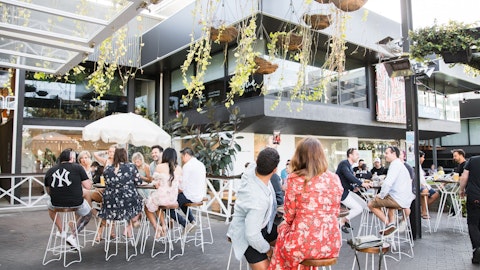Brian Vaccaro: Okay. Understood. Fair enough. My follow-up, I guess, is on the margin front. And I guess I’ll take the other OpEx line here. saw quite a bit of leverage on the other OpEx line, I guess, versus our expectations or compared to what you saw in last quarter, we’re trying to base it out a little bit. Can you just kind of at a high level, move through some of the puts and takes? I know sometimes there are swings in marketing, swings in R&M and other spend levels that might show up in that line. Mike, any help on sort of the puts and takes on that line in the quarter would be very helpful. Thank you.
Michael Quartieri: Yes. I think from a puts and takes perspective, I think we continue to see higher costs this area. Two components of that. Part of it is external janitorial services as we — as we’ve talked about before, as we reopened post-pandemic, finding labor was difficult, so we did a lot of outsourcing at that point. As we are seeing today a recovery in the labor market where we’ve got 12% more job applicants for physicians today than we saw a year ago, we are able to now start going back on a strategic basis and looking and evaluating whether those costs are better off in-house versus external. So, there is that piece of business that’s going. We continue to see higher costs around security wage inflation there has not come down.
When you’re asked to include security from the local municipality because of certain areas that they have got back on, that is a cost that we’re absorbing, and we want to do that. Because we take the safety of our customers, first and foremost, as one of the most important table stakes they have and choosing to come to a Dave & Buster’s or a Main Event. We also look at things from a repairs and maintenance perspective. We are looking through — if you kind of go back post pandemic, there was a lot of deferred maintenance in the building. So some people have come back and we have made a little bit more of investment there on the R&M side from an expense perspective. Now, the recovery aspects of what’s offsetting some of that is the utility costs that we spoke about before, it was a very hot summer that we all had extreme higher energy costs that we had to deal with, not only from the usage, but also from a rate perspective, that utilization is obviously coming down as we get to the cooler months of the winter time.
And so those are pretty much the four puts and takes that we have.
Brian Vaccaro: Appreciate that. I’ll pass it along. Thank you.
Michael Quartieri: You got it.
Operator: The next question will come from Jeff Farmer with Gordon Haskett. Please go ahead.
Jeff Farmer: Thanks. I have a couple of questions for you guys. So, can you just update us on what you’re seeing from the lower-income consumer? How large is this cohort for you guys? And how are they behaving?
Chris Morris: Sure, I’ll take that. We’ve €“ we’re constantly trying to understand our business, understand the trends and certainly understanding how our guest profiles are impacting our business. And there’s really nothing noteworthy there. We — there’s still strength in our business across all demos. We’re not seeing — we haven’t seen a disproportionate shift in trends on a lower end consumer.
Jeff Farmer: Okay. And then just really two modeling ones. The first is simple, which is which — what interest rate should we be using in the model, considering the movement in rates out there. And then you guys were talking about 25% commodity inflation. Last time we heard from you. What’s the update there?
Michael Quartieri: Let me start off with commodity inflation. So if you’re looking at 21, I should say, versus 21. In Q2, we were up 17%. In Q3, we’re only up 9%. And a lot of piece of that is the work that we’ve been doing around our synergies and really driving home on the renegotiation of contracts and combined purchasing power to lower our commodity costs at that point. When you look at our interest rate, remember, we’ve got the 7.625 notes that are outstanding. And when you’re looking at LIBOR — or sorry, LIBOR — SOFR, where at SOFR plus 500 is the term loan. So you could just look at the forward yield curve for SOFR for the next year, and that will give you your interest rate.
Jeff Farmer: Okay. Thank you.
Operator: The next question will come from Sharon Zackfia with William Blair. Please go ahead.
Sharon Zackfia: Hi, good afternoon. I guess the question on the spend per card. I know that it’s been quite elevated kind of in the early innings coming out of the pandemic for Dave & Buster’s. How has that been trending now as we’ve gotten to maybe a more normalized pandemic status with the consumer?
Michael Quartieri: Yes, we are at a same consistent level of what we saw coming out of the pandemic. So if you look at it over the last year, we’ve seen no decline in the average transaction value of the power card of kiosks.





